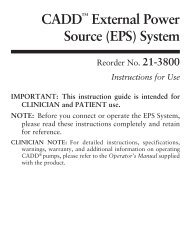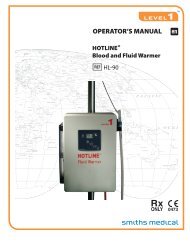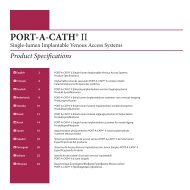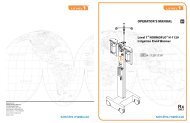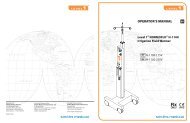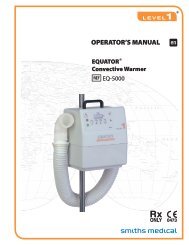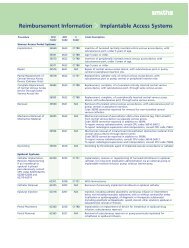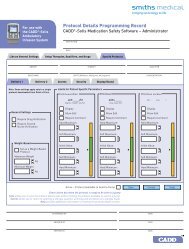40-5124-24C IFU, ProPort.indd - Smiths Medical
40-5124-24C IFU, ProPort.indd - Smiths Medical
40-5124-24C IFU, ProPort.indd - Smiths Medical
Create successful ePaper yourself
Turn your PDF publications into a flip-book with our unique Google optimized e-Paper software.
A. Percutaneous Puncture – Method A (Interventional Radiologists), a<br />
technique commonly used by interventional radiologists for inserting the<br />
catheter over a guidewire.<br />
B. Percutaneous Puncture – Method B (Surgeons), a technique commonly<br />
used by surgeons for inserting the catheter through the introducer sheath<br />
after removing the guidewire.<br />
C. Surgical Cutdown, a technique utilizing direct exposure of the vein to aid<br />
in catheter insertion.<br />
A. Percutaneous Puncture – Method A<br />
(Interventional Radiologists)<br />
This technique describes the use of a 21 gauge (0.81 mm) introducer needle, 0.018<br />
in. (0.46 mm) guidewire, 4 Fr (1.35 mm) transitional dilating system (coaxial<br />
catheter), and a 0.035 in. (0.89 mm) hydrophilic guidewire which are not supplied<br />
with PORT-A-CATH® and PORT-A-CATH® II systems.<br />
1. Place the patient in a supine position. Select the appropriate site for placement<br />
of the catheter and portal. Verify the vein pathway using fluoroscopy or<br />
ultrasound.<br />
2. Prepare the puncture site by using standard aseptic technique and anesthetize<br />
the vein insertion site.<br />
3. For chest placement, puncture the skin with a 21 gauge (0.81 mm) introducer<br />
needle (not supplied) below the clavicle at the lateral aspect of the junction of<br />
its medial and middle third. To confirm that the needle is in the subclavian<br />
vein, attach a syringe and aspirate gently as the needle is directed toward a<br />
point slightly above and behind the suprasternal notch.<br />
4. Remove the syringe if necessary, leaving the needle in place.<br />
5. Insert a 0.018 in. (0.46 mm) guidewire through the needle.<br />
6. Under fluoroscopic guidance, advance the guidewire tip to the desired location.<br />
7. Remove the needle and discard it, leaving the guidewire in place.<br />
8. Advance a 4 Fr (1.35 mm) transitional dilating system (coaxial catheter) over<br />
the 0.018 in. (0.46 mm) guidewire. Remove the inner section of the transitional<br />
dilating system.<br />
9. Exchange the 0.018 in. (0.46 mm) guidewire with a 0.035 in. (0.89 mm) hydrophilic<br />
guidewire. To reduce the opportunity for air embolism, place a finger over the<br />
opened sheath until the catheter is inserted.<br />
10. Replace the remaining section of the transitional dilating system with the<br />
6 Fr (2.0 mm) dilator/sheath assembly using a twisting motion to advance the<br />
assembly into the vein.<br />
11. Remove the dilator from the introducer sheath, leaving the sheath in place<br />
(Figure 1: A–Squeeze, B–Pull Back, C–Sheath, D–Dilator).<br />
12. Place the end of the catheter (tipped end of polyurethane catheters) over the<br />
hydrophilic guidewire and through the sheath and advance the catheter along<br />
the hydrophilic guidewire to the desired location.<br />
13. Withdraw the hydrophilic guidewire after the catheter tip is positioned.<br />
14. Withdraw the sheath from the vessel gradually and, if using a peel away<br />
sheath, at the same time pull outwards on the two tabs of the sheath peeling it<br />
away from the catheter.<br />
15.<br />
16.<br />
17.<br />
WARNING: Failure to withdraw the sheath prior to peeling it may result in<br />
tearing of the vein.<br />
Using the blunt needle and a 10-ml or larger syringe, flush the catheter with<br />
5 ml of heparin solution (10 to 100 IU/ml) and clamp it closed at the end to be<br />
connected to the portal.<br />
Confirm by fluoroscopy or x-ray that the distal tip of the catheter is positioned<br />
at the desired location.<br />
If appropriate, tunnel the catheter from the insertion site to the location for<br />
the portal pocket.<br />
Proceed to Portal Site Preparation.<br />
B. Percutaneous Puncture – Method B<br />
(Surgeons)<br />
NOTE: When using pre-assembled or preconnected systems, first prepare the<br />
portal pocket and then tunnel the catheter from the portal pocket to the vein<br />
entry site. (See Portal and Site Preparation.) Before inserting the catheter in<br />
the vein, determine the length needed and trim the distal end of the catheter<br />
at a right angle.<br />
This technique describes the use of an 18 gauge (1.3 mm) introducer needle, a<br />
0.035 in. (0.89 mm) J-guidewire, and a 6 Fr (2.0 mm) introducer/sheath assembly<br />
which are supplied with certain <strong>ProPort</strong> systems.<br />
1. Place the patient in a supine position and select the appropriate vein for<br />
placement of the portal and catheter. Mark the site for venipuncture.<br />
2. Prepare the puncture site by using standard aseptic technique and anesthetize<br />
the vein insertion site.<br />
3. Puncture the skin with an 18 gauge (1.3 mm) introducer needle below the<br />
clavicle at the lateral aspect of the junction of its medial and middle third. To<br />
confirm that the needle is in the subclavian vein, attach a syringe and aspirate<br />
gently as the needle is directed toward a point slightly above and behind the<br />
suprasternal notch.<br />
4. Remove the syringe if necessary, leaving the needle in place.<br />
5. Slide the guidewire straightener over the 0.035 in. (0.89 mm) guidewire. Insert<br />
the guidewire through the needle, far enough into the vein to determine that<br />
the venous pathway is open.<br />
6. Withdraw and discard the needle and guidewire straightener, leaving the<br />
guidewire in place.<br />
7. Make a small incision in the skin at the vein entry site to insert the dilator and<br />
sheath assembly into the vein.<br />
8. Introduce the dilator and sheath assembly over the guidewire with a twisting<br />
motion and advance the assembly just past the soft tissue into the vein.<br />
9. Remove the dilator and guidewire, leaving the sheath in place. (Figure 1:<br />
A–Squeeze, B–Pull Back, C–Sheath, D–Dilator). To reduce the opportunity<br />
for air embolism, place a finger over the opened sheath until the catheter is<br />
inserted.<br />
10. Advance the catheter (tipped end of polyurethane catheters) slowly and in<br />
short increments through the sheath to the desired location.<br />
11. Withdraw the introducer sheath from the vessel gradually and, if using a peel<br />
away sheath, at the same time pull outwards on the two tabs of the sheath<br />
peeling it away from the catheter.<br />
12.<br />
WARNING: Failure to withdraw the sheath prior to peeling it may result in<br />
tearing of the vein.<br />
For unassembled systems, using the blunt needle and a 10-ml or larger<br />
syringe, flush the catheter with 5 ml heparin solution (10 to 100 IU/ml) and<br />
clamp it closed.<br />
For pre-assembled or preconnected systems, penetrate the septum with a<br />
non-coring PORT-A-CATH® access needle and flush the system using a 10 ml<br />
or larger syringe filled with 5 ml of heparin solution (10 to 100 IU/ml). Take<br />
care not to manipulate the catheter/portal connection as system damage or<br />
disconnection of the catheter from the portal could occur.<br />
13. Confirm by fluoroscopy or x-ray that the distal tip of the catheter is positioned<br />
at the desired location.<br />
14.<br />
For unassembled systems, tunnel the catheter from the insertion site to the<br />
location for the portal pocket.<br />
Proceed to Portal and Site Preparation.<br />
5



